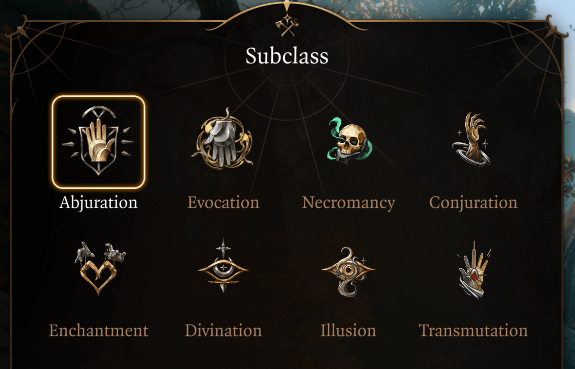Everything You Should Know About the Baldur’s Gate 3 Wizard and its Subclasses
With endless arcane knowledge and a diverse spellbook to match, the Wizard is one of the most versatile and adaptive classes in Baldur’s Gate 3.
Strap up your robes, in this guide we will cover both the pros and cons of the Wizard compared to the other classes, as well as the individual playstyles of each school of magic.
So whether you’re considering playing a Wizard or having Gale, the default Wizard companion in your party, stick around!
Find out where the Wizard ranks in our Baldur’s Gate 3 class tier list.
Pros and Cons
Pros
- Largest spellbook of any other class (can permanently learn from Scrolls!)
- One of the most adaptive and unique play styles with the largest amount of subclasses, suit up for any occasion!
- Being the only class that specializes in INT, you will enjoy some unique dialogue options as well as knowledge checks!
Cons
- Less raw damage potential than the Sorcerer, who benefits from Metamagic
- Cannot recover spell slots during Short Rests like Warlock
- Early game can be rather painful as many enemies will one-shot you due to a slow ramp-up
Years of studying and developing strong Intellect has given Wizards the unique ability to study Spell Scrolls and permanently learn the spell written on it.
This, combined with being able to change out your prepared spells in any non-combative area makes Wizards an effective Swiss Army Knife of utility and power.
Wizards completely focus on their Spells as their main damage output. Unlike Sorcerers, who boast more raw damage output with Metamagic – or Warlocks who can recover spells on a short rest, Wizards take their power from having a massive array of spells at their disposal.
In a roleplaying environment, Wizards are the intellects – reflected in the majority of their magic all boasting INT throws. Wizards are seen as scholars, translators, and well-studied on topics like Arcana, History, Religion and Nature. Wizards always thirst for more knowledge; be it on how to brew a potion or how to travel between planar rifts.

Being a master of Arcana, Wizards possess properties that no other party member can bring to the table – Who else is going to decipher those glyphs? Is that a child’s ball or a dimensional bomb, who knows?
Upon reaching Wizard level 2, players will have the choice between eight Subclasses, which are flavored as different schools of magic. This does not prevent the Wizard from learning spells from other schools of magic, however – feel free to equip yourself with your favorite array of spells, and change it out on the fly if encounters don’t go the way you expect.
Subclasses (Schools of Magic)
There are eight subclasses for Wizards in Baldur’s Gate 3. Each subclass is a different school of magic for the Wizards to discipline themselves in.

In addition to a new array of spells, Wizards also find it easier and therefore cheaper to learn spells from their chosen school of magic.
- Abjuration
- Conjuration
- Divination
- Enchantment
- Evocation
- Illusion
- Necromancy
- Transmutation
Abjuration
| Level | Feature | Description |
|---|---|---|
| 2 |
Arcane Ward |
|
| 6 |
Projected Ward |
|
| 10 |
Improved Abjuration |
|
Abjuration spells summon wards, banish enemies, and nullify magic, suitable for those who wish to defend themselves and others.
Abjuration Wizards focus on the defensive capabilities provided by the Arcane Ward; this can prove to be extremely beneficial in parties that lack a dedicated tank, or squishier parties in general.
Conjuration
| Level | Feature | Description |
|---|---|---|
| 2 |
Minor Conjuration: Create Water |
|
| 6 |
Benign Transposition: Teleport |
|
| 10 |
Focused Conjuration |
|
Conjuration Wizards are masters of utility, whether you summon a creature out of thin air, conjure up a rain cloud to extinguish a field of fire, or teleport across vast spaces.
Compelled by shape and motion, your favored arcane style involves summoning creatures and objects, as well as displacing them in space.
Divination
| Level | Feature | Description |
|---|---|---|
| 2 |
Portent |
|
| 6 |
Expert Divination |
|
| 10 |
Third Eye: Darkvision |
|
| 10 |
Third Eye: See Invisibility |
|
With the power to control fate, Divination Wizards provide a unique ability to your party: letting them re-roll a failed Attack Roll or Saving Throw.
Divination Wizards work wonders with other members who want to land those strong hits, and a second chance may be what they need to turn a battle around.
You peer through time itself and can sculpt the future, like temporal clay, into a more favorable form.
Enchantment
| Level | Feature | Description |
|---|---|---|
| 2 |
Hypnotic Gaze |
|
| 6 |
Instinctive Charm |
|
| 10 |
Split Enchantment |
|
Enchantment Wizards focus on more of a supportive role with tons of crowd control. From effects such as charms, confusion, and irresistible dances, your enemies aren’t going anywhere while your party butchers them down!
Your magic influences, beguiles, and bends the will and conviction of those around you.
Evocation
| Level | Feature | Description |
|---|---|---|
| 2 |
Sculpt Spells |
|
| 6 |
Potent Cantrip |
|
| 10 |
Empowered Evocation |
|
Evocation spells focus elemental energy into powerful attacks and enchantments. Those who specialize in this school are known as evokers.
One of the more offensive schools of magic; Evocation Wizards focus on the offensive and ensure that damaging spells and cantrips output as much damage as possible, while ensuring your allies remain safe from the blasts.
Illusion
| Level | Feature | Description |
|---|---|---|
| 2 |
Improved Minor Illusion |
|
| 6 |
See Invisibility |
|
| 10 |
Illusory Self |
|
Illusion Wizards specialize in unraveling and restitching the fabric of reality to fool the unwary, the gullible, and the monstrous.
Whether summoning an illusion or becoming one; the Illusion Wizard is all about trickery and guile.
Furthering study into Illusion magic grants invisibility, disguises, and distractions – creating the stealthiest of the Wizards.
Necromancy
| Level | Feature | Description |
|---|---|---|
| 2 |
Grim Harvest |
|
| 6 | Animate Dead |
|
| 10 |
Undead Thralls: Additional Undead |
|
| 10 |
Undead Thralls: Better Summons |
|
| 10 |
Inured to Undeath |
|
Necromancy Wizards walk through the valley of the shadow of death, and make lots of friends there. Masters of life and death, reanimate corpses to fight for a better cause (yours).
Become feared with an unlimited army of the undead at your side. Necromancy has been rejected by many societies; seen as a forbidden or taboo art. Tread carefully.
Transmutation
| Level | Feature | Description |
|---|---|---|
| 2 |
Experimental Alchemy |
|
| 6 | Transmuter’s Stone |
|
| 10 | Shapechanger |
|
Your innate fascination with the structure of things has granted you incredible power over crude matter and its manipulation.
Shifting and warping the world around them, Transmutation Wizards provide utility such as feather-falling, or faster retreats.
With enough study, Transmutation Wizards can render someone’s flesh into immovable stone, or drop them from 18m in the air.
So which Wizard subclass should you play?
If you want to emphasize protecting your party and nullifying threats, choose Abjuration.
Want to summon creatures, objects, and other effects? Choose Conjuration.
If you want to peer into the future and influence fate, choose Divination
To become a master of crowd control and charms, choose Enchantment.
For raw power boosts to your offensive magic, choose Evocation.
Looking to go stealthy or trick your enemies? Choose Illusion.
If you want to take a darker approach and reanimate the dead for your goals, choose Necromancer.
To get more value out of extracts and buff your party more often, choose Transmutation.
Lastly, remember you can easily respec your character for just 100g so feel free to try out different schools!
 Download APP
Download APP